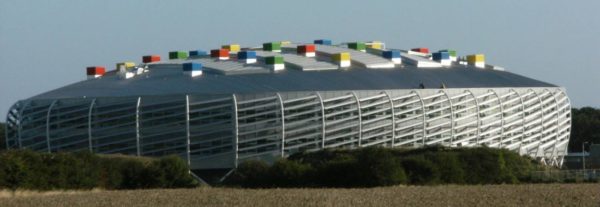Hybrid Ventilation: Breathing life into buildings
As buildings become more contemporary in their design, sustainable strategies, such as natural and hybrid ventilation, are becoming increasingly important to a structure’s core principles.
Not only does such an approach allow for a building to use 60% less energy, it can also drastically improve the air quality for the occupants within.
Add to this the impact of government targets to reduce carbon emissions, and it’s easy to see why more architects are now embracing this green building revolution.
How does it work?
Natural ventilation takes advantage of wind and buoyancy in order to drive fresh air through a building. This removes the need for energy-intensive air handling units – which can be expensive in terms of installation, energy use and maintenance. Purely passive ventilation, however, may not always be the best solution for balancing thermal comfort, air quality and energy use in a ventilation strategy which works all year around.
Why use hybrid ventilation?
For a start, it costs less to use than some other ventilation methods. By making best use of natural driving forces, an intelligently-designed hybrid mixing ventilation system saves energy all year around, and can lead to much cheaper energy bills:
- In summer, fan energy use is reduced or eliminated, by making best use of the natural driving forces.
- In winter, heating bills are greatly reduced, through the use of mixing ventilation to recycle the internal heat gains.
In fact, according to a Carbon Trust case study, a building which uses natural or hybrid ventilation can save an average of £30,000 a year on energy.
In the UK, buildings contribute just under half of the country’s total carbon emissions, tackling this issue will greatly benefit the environment on a wider scale. Research, carried out by the Carbon Trust, found that the majority of buildings which utilised natural/hybrid ventilation saved 24 – 71% of carbon emissions.
A further advantage of of hybrid-natural ventilation is that it typically requires far less maintenance, when compared with conventional AHU air conditioning. What’s more, it gives a building’s occupants more control over their surrounding environment, as well as making them more comfortable.
Educational establishments can greatly benefit from the supply of fresh air; research from the Lawrence Berkeley National Laboratory suggests that improving fresh air provision can reduce the rate of student absence due to illness by approximately 3.4%.
A versatile solution
Most occupied buildings are viable for hybrid ventilation. Such systems can work in isolation, but more commonly, they are employed in conjunction with other energy-efficient systems. Offices, schools, universities, health centres and council buildings can all make use of this type of sustainable ventilation strategy.
Although it is best to design and integrate the ventilation strategy at the earliest possible stage, it can be introduced later, as a part of a retrofit project, meaning that existing buildings can still benefit on some level.
So, now that you are aware of the benefits that natural and hybrid ventilation can offer, what’s stopping you from joining the green revolution? Breathing Buildings’ ventilation specialists would be very pleased to share our expert knowledge on hybrid and natural ventilation – so for more info and to continue the discussion, call us on 01223 450060.

